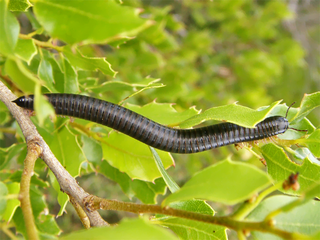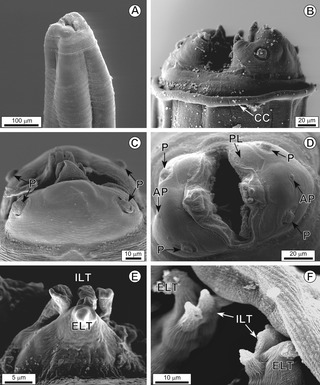
Secernentea was a class of nematodes in the Classical Phylogeny System and is no longer in use. This morphological-based classification system has been replaced by the Modern Phylogeny system, where taxonomy assignment is based on small subunit ribosomal DNA.

Heterorhabditis is a genus of nematodes belonging to the order Rhabditida. All species of this genus are obligate parasites of insects, and some are used as biological control agents for the control of pest insects.

Caenorhabditis is a genus of nematodes which live in bacteria-rich environments like compost piles, decaying dead animals and rotting fruit. The name comes from Greek: caeno- ; rhabditis = rod-like.
Tetrameridae is a family of spirurian nematodes. It is the smallest of the large genera making up the bulk of the superfamily Habronematoidea. Like all nematodes, they have neither a circulatory nor a respiratory system. They are parasites, chiefly of birds and cetaceans.

Mermithidae is a family of nematode worms that are endoparasites in arthropods. As early as 1877, Mermithidae was listed as one of nine subdivisions of the Nematoidea. Mermithidae are confused with the horsehair worms of the phylum Nematomorpha that have a similar life history and appearance.
Angiostoma is a genus of parasitic nematodes in the family Angiostomatidae.

Ommatoiulus moreleti, commonly known as the Portuguese millipede, is a herbivorous millipede native to the western Iberian Peninsula where it shares its range with other Ommatoiulus species. From here, it has spread by international commerce to a number of new localities. This species was accidentally introduced into Australia without its natural enemies and has since become an invasive pest. A number of methods have been developed to manage this millipede.

Hassalstrongylus is a genus of nematode worms that infect mostly muroid rodents from eastern North America to South America. The genus is part of the Heligmonellidae and related to genera like Stilestrongylus.

Sphaerotheriida is an order of millipedes in the infraclass Pentazonia, sometimes known as giant pill millipedes. They inhabit Southern Africa, Madagascar, South and Southeast Asia, Australia and New Zealand. Like the Northern Hemisphere pill millipedes of the order Glomerida, these millipedes can roll into a ball when disturbed. When they are rolled-up, most sphaerotheriidans reach a maximum size of a cherry or golf ball, but some species from Madagascar can even reach the size of an orange. When rolled-up, predators are unable to unravel giant pill millipedes since the margins of their second and last dorsal plates fit perfectly into one another, creating a sealed ball. A few giant pill millipede species are able to produce sound, the only millipedes known to do this. This order of millipedes is also unique in that some African species are used for medicinal purposes.
Myleusnema bicornis is an intestinal parasite of Myleus ternetzi, or "Ternetz's Silver Dollar", a freshwater Characoid fish commonly found in the French Guiana river. M. bicornis has several unusual morphological characteristics, namely the two postcloacal "horns" in the posterior of males, and a separate elongated cephalic region (head) that may be extended and retracted. These features differ vastly from other Cosmocercoidean nematodes, as well as any others within the family Kathlaniidae, and as such necessitate the creation of the new genus Myleusnema; however, no genetic taxonomic studies have been performed.

Huffmanela is a genus of parasitic nematodes, belonging to the family Trichosomoididae.
Durikainema is a genus of two nematodes in the family Robertdollfusiidae. Species have a head with a cuticular cephalic inflation, elongated papillae and amphids, and well-developed musculature. Characteristics of the males include a single spicule and a long attenuated tail. Durikainema species parasitize macropods. The genus was circumscribed in 1982 with the type species Durikainema macropi, a parasite of the eastern grey kangaroo. D. phascolarcti, parasite of the koala, was described in 1998.

Pristionchus is a genus of nematodes (roundworms) in the family Diplogastridae that currently includes more than 50 described species. They are known mainly as non-parasitic associates of insects, especially beetles, while others have been reported from soil, organic matter, or rotting wood. The genus includes P. pacificus, a satellite model organism to the well-studied nematode Caenorhabditis elegans.
Traklosiidae is a family of nematodes. It is in the superfamily Coronostomatoidea.
Coronostomatoidea is a superfamily of nematodes. Its type family is Coronostomatidae, which was circumscribed in 1961 by G. R. Kloss. The superfamily was initially circumscribed in 1977 by George Poinar Jr. and then re-established in 2016 by Gary Phillips and colleagues. This superfamily consists of the families Coronostomatidae and Traklosiidae.

Physalopteridae is a family of spirurian nematodes, which belongs to the superfamily Physalopteroidea. Like all nematodes, they have neither a circulatory nor a respiratory system.

Rasheedia is a genus of nematodes in the order Spirurida. The nematode genus BulbocephalusRasheed, 1966 was found to be a homonym of BulbocephalusWatson, 1916 and, therefore, a new name, Rasheedia n. nom., was proposed in 2018 to substitute it.

František Moravec is a Czech parasitologist who specialises on the Nematodes, especially the nematodes parasites of fishes. His research is mainly in the field of taxonomy of the Nematoda.
Artigasia is a genus of nematodes belonging to the family Hystrignathidae. It was described from the gut caeca of Passalus interstitialis found in Escaleras de Jaruco, La Habana Province, and El Pan de Matanzas, Matanzas Province, both in Cuba.











